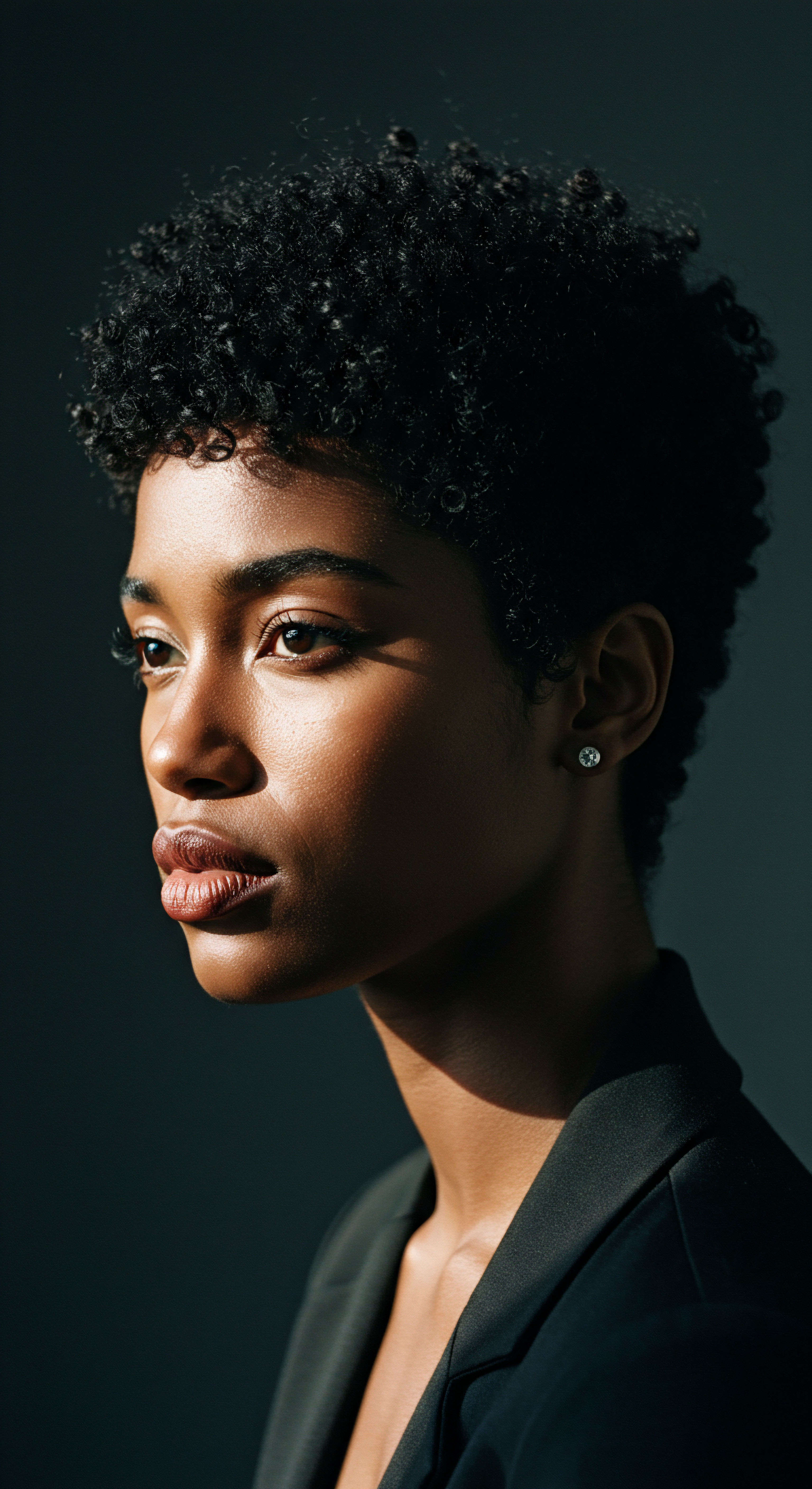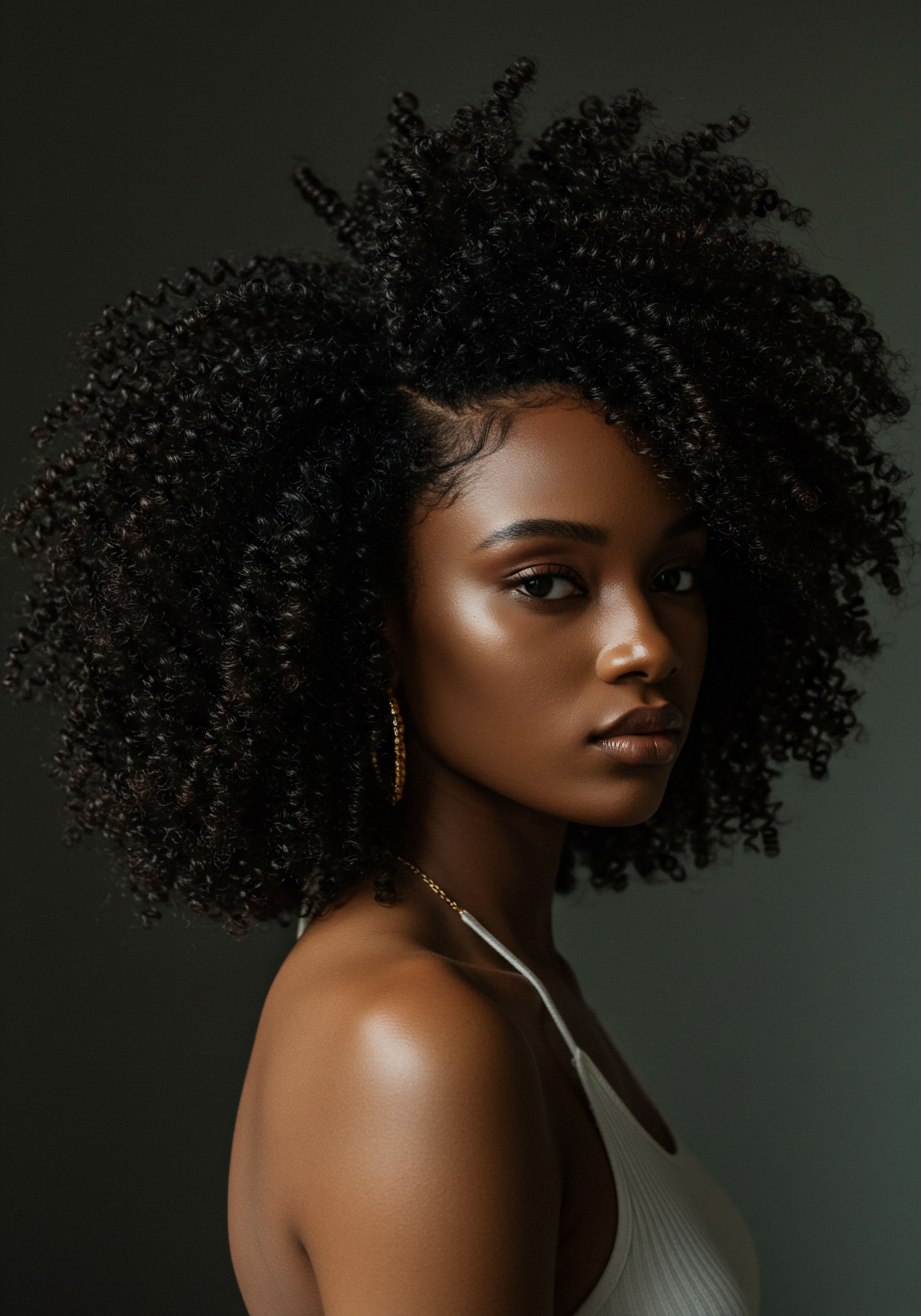
Roots
The quiet hours of slumber, often perceived as a simple cessation of daily activity, hold a profound significance for every cell within our being, including the intricate structures that produce our hair. For those with textured hair, a rich legacy of care and observation often guides daily practices, yet the invisible dance of cellular repair and hormonal regulation during sleep remains a less explored, yet equally vital, aspect of vitality. Understanding how the body’s internal rhythms align with rest offers a pathway to appreciating the fundamental processes that govern hair growth, from the scalp’s surface to the very core of each strand.

The Body’s Nightly Restoration
During the deepest stages of sleep, our bodies orchestrate a symphony of repair and regeneration. This period is when cellular turnover accelerates, tissues mend, and energy stores replenish. For hair, this translates to an active period of follicle rejuvenation.
The hair follicle, a mini-organ in itself, relies on these restorative cycles to maintain its vigor and continue its production of healthy strands. When adequate rest is withheld, these crucial repair mechanisms falter, potentially impacting the vitality of hair.

How Cellular Activity Influences Hair Growth
The cells within the hair follicle undergo rapid division and differentiation, particularly during the anagen, or growth, phase. This intense cellular activity demands considerable energy and resources. Sleep provides the optimal environment for these processes.
During sleep, the body increases Protein Synthesis, a fundamental process for creating keratin, the primary structural protein of hair. Without sufficient protein synthesis, the building blocks for strong, resilient hair become scarce, potentially leading to weaker strands more prone to breakage.
Moreover, the scalp itself, the very ground from which textured hair springs, benefits immensely from nighttime repair. Proper blood flow, which delivers essential oxygen and nutrients to hair follicles, is optimized during restful sleep. This enhanced circulation ensures that the cells responsible for hair production receive the nourishment they require to function at their best. A well-nourished scalp creates a fertile environment for hair to thrive, supporting its natural growth trajectory.
The deepest stages of sleep are a crucial time for cellular repair and regeneration, directly influencing the vitality of hair follicles and the strength of each strand.

The Hair Growth Cycle and Sleep’s Role
Hair does not grow in a continuous, linear fashion; rather, each strand follows a repeating cycle. This cycle comprises three main phases:
- Anagen ❉ The active growth phase, lasting several years, during which hair actively lengthens.
- Catagen ❉ A short transitional phase where hair growth slows, and the hair follicle begins to shrink.
- Telogen ❉ The resting phase, lasting a few months, where hair remains in the follicle but is dormant before eventually shedding to make way for new growth.
Sleep plays a significant part in maintaining the delicate balance of this cycle. During deep sleep, the body prioritizes functions that influence hair follicle activity in the anagen phase, potentially promoting optimal growth. Conversely, insufficient sleep can disrupt this natural rhythm, potentially pushing more follicles into the resting phase prematurely, which may lead to increased shedding and noticeable thinning. This disruption highlights the interconnectedness of sleep patterns and the hair’s inherent growth rhythm.
The precise timing of cellular events within the hair follicle is influenced by the body’s internal clock, known as the circadian rhythm. This biological rhythm, which operates on an approximately 24-hour cycle, governs various physiological processes, including cell division and metabolism. Research suggests that the circadian clock directly modulates the hair follicle cycle.
For instance, studies have shown that disrupting core clock genes, such as BMAL1 and PER1, can affect the progression of the hair growth phase. This indicates that a consistent sleep-wake schedule, which supports a healthy circadian rhythm, contributes to the orderly progression of the hair growth cycle.

Ritual
The quiet hours of night, often considered a time for stillness, are anything but for our bodies and our hair. As we seek practical wisdom for our textured strands, turning our attention to the nightly practices and the often-overlooked influence of rest offers a fresh perspective. The journey of hair care extends beyond daytime routines, finding a significant, yet often unspoken, chapter in our hours of repose. This section delves into the actionable ways sleep duration, and the rituals surrounding it, shape the very condition of our hair, providing gentle guidance for enhanced vitality.

How Sleep Duration Affects Hair Quality
The length of our sleep directly influences the body’s capacity for systemic restoration. When sleep is consistently cut short, the body operates under a state of chronic stress, triggering a cascade of physiological responses that can compromise hair quality. Adequate sleep, generally 7 to 9 hours for most adults, allows for sustained periods of cellular repair and hormonal regulation, both of which are critical for healthy hair.

Hormonal Balance and Hair Health
Sleep is a period of intense hormonal activity. During deep sleep, the body releases Growth Hormone, a crucial factor in cell regeneration, including the repair and growth of hair follicles. Melatonin, primarily known for regulating sleep-wake cycles, also plays a significant role in hair health. It acts as a potent antioxidant, protecting hair follicles from oxidative stress, and may even stimulate cell growth.
Conversely, sleep deprivation can lead to elevated levels of cortisol, often called the “stress hormone.” Chronic high cortisol levels can disrupt the hair growth cycle, potentially shortening the anagen phase and prematurely pushing follicles into the resting phase, leading to increased shedding. This hormonal imbalance can make textured hair feel drier, appear duller, and become more susceptible to breakage.
Insufficient sleep can elevate stress hormones and reduce beneficial growth factors, directly hindering the hair’s natural vitality and making it more prone to thinning.

Practical Nighttime Hair Protection
Beyond the internal biological processes, the physical protection of textured hair during sleep is a long-held tradition that holds significant scientific merit. Textured hair, with its unique curl patterns and natural dryness, is particularly vulnerable to friction and moisture loss during the night.

The Significance of Protective Head Coverings
Sleeping on rough surfaces, such as cotton pillowcases, can create friction against hair strands, leading to tangles, breakage, and frizz. This is especially true for textured hair, where the natural curl patterns can easily snag and pull.
- Silk Pillowcases ❉ These provide a smooth surface that reduces friction, allowing hair to glide without snagging. This minimizes breakage and helps preserve moisture.
- Satin Bonnets or Scarves ❉ These coverings offer a protective barrier, enclosing the hair and preventing it from rubbing against bedding. They also help to seal in moisture from nighttime products, keeping strands hydrated.
These simple tools, often passed down through generations, serve as essential components of a nighttime ritual aimed at preserving the integrity and health of textured hair. They work in tandem with the body’s internal restorative processes to create an optimal environment for hair growth and retention.

Why Should Hair Be Dry Before Sleep?
Sleeping with wet hair, particularly for textured strands, can exacerbate damage. Wet hair is more fragile and susceptible to breakage when subjected to the friction of tossing and turning. Additionally, a damp scalp can create a breeding ground for yeast and bacteria, potentially leading to scalp issues that compromise hair health. Ensuring hair is completely dry before bed helps to maintain its structural integrity and prevents potential microbial imbalances on the scalp.
| Practice Use Silk/Satin Pillowcases |
| Benefit for Textured Hair Reduces friction and tangling, preserves curl pattern. |
| Underlying Mechanism Smooth surface prevents mechanical stress and moisture absorption from hair. |
| Practice Wear a Satin Bonnet/Scarf |
| Benefit for Textured Hair Protects hair from friction, retains moisture. |
| Underlying Mechanism Encases hair, preventing direct contact with bedding and minimizing moisture evaporation. |
| Practice Ensure Hair is Dry |
| Benefit for Textured Hair Prevents breakage and scalp issues. |
| Underlying Mechanism Wet hair is more fragile; damp scalp can foster microbial growth. |
| Practice Gentle Detangling |
| Benefit for Textured Hair Minimizes knots and reduces breakage. |
| Underlying Mechanism Removes tangles before they worsen with movement during sleep. |
| Practice These practices complement the body's internal repair processes during sleep, supporting overall hair vitality. |

Relay
To consider the influence of sleep on textured hair growth requires moving beyond surface-level observations, venturing into the profound interplay of biological, psychological, and even subtle environmental factors. This deeper inquiry reveals how rest, or its absence, can reverberate through our entire system, ultimately manifesting in the very strands that crown our heads. The exploration here seeks to uncover less apparent complexities, inviting a thoughtful consideration of how science and lived experience converge in the quiet hours of the night.

How Does Circadian Rhythm Influence Hair Follicle Behavior?
The human body operates on an intricate internal clock, the circadian rhythm, which orchestrates a multitude of physiological processes over approximately 24 hours. This rhythm influences cell division, hormone secretion, and immune function, all of which bear directly on hair health. Hair follicles themselves possess their own peripheral circadian clocks, indicating that their activity is synchronized with the body’s broader rhythms.
Research highlights that disruptions to this circadian timing system, such as those experienced by shift workers, can impact the regenerative properties of hair precursor cells. A 2019 study published in Cell Reports demonstrated a link between circadian rhythm disruptions and decreased stem cell activity in hair follicles. This research, conducted on mice, suggested that chronic disruption can reduce the regenerative capacity of these cells over time, potentially leading to thinner, weaker hair. While direct human studies on this specific mechanism in textured hair are still evolving, the underlying biological principles suggest a universal impact on hair follicle vitality.

The Interplay of Hormones and Sleep Cycles
The precise regulation of hormones during sleep is paramount for sustained hair growth. Beyond growth hormone and melatonin, other endocrine signals are finely tuned during periods of rest. Cortisol, the stress hormone, exhibits a diurnal rhythm, with levels typically decreasing at night to allow for restorative sleep. Chronic sleep deprivation disrupts this natural rhythm, leading to sustained elevated cortisol levels.
Elevated cortisol levels can directly affect the hair follicle. Studies have shown that high cortisol concentrations can reduce the synthesis and accelerate the degradation of important skin elements like hyaluronan and proteoglycans by approximately 40%. These substances are crucial for the healthy extracellular matrix surrounding hair follicles, which provides structural support and signaling cues for hair growth. A compromised extracellular matrix can impair the hair follicle’s ability to cycle effectively and produce robust strands.
Furthermore, hormonal imbalances extending beyond cortisol, such as those related to thyroid function or reproductive hormones, can be exacerbated by poor sleep. These imbalances can manifest as changes in hair texture, density, and growth rate, particularly noticeable in textured hair, which is often more susceptible to external and internal stressors.

What Role Does Systemic Health Play in Hair Vitality?
Hair is often considered a barometer of overall health. The body prioritizes essential functions, and when faced with chronic sleep deficit, non-essential processes, including hair growth, may receive fewer resources. This redirection of energy can lead to a less vibrant hair appearance and reduced growth.

Immune System Modulation and Hair Follicle Integrity
Sleep significantly influences the immune system. Chronic sleep deprivation can weaken immune function, potentially leading to increased inflammation throughout the body, including the scalp. Hair follicles, while possessing a degree of “immune privilege,” can be vulnerable to inflammatory responses. Pro-inflammatory cytokines, signaling molecules released by immune cells, can alter hair cycle dynamics, shortening the anagen phase and accelerating the transition into the telogen phase, resulting in premature shedding.
A compromised immune system may also struggle to maintain a healthy scalp microbiome, the delicate balance of microorganisms residing on the scalp. An imbalanced microbiome can contribute to scalp irritation, dandruff, and other conditions that indirectly impede healthy hair growth. Ensuring adequate sleep helps maintain a robust immune system, thereby supporting a healthy scalp environment for textured hair.
The delicate balance of hormones, the integrity of the immune system, and the rhythmic cellular activities are all profoundly influenced by sleep, directly impacting hair vitality.

How Does Stress from Sleep Disruption Affect Hair Growth?
The relationship between sleep, stress, and hair health is cyclical and often self-perpetuating. Lack of sleep is a significant physiological stressor. This stress response triggers the release of cortisol, as previously discussed, which directly interferes with the hair growth cycle.
Moreover, the psychological stress associated with chronic sleep deprivation can contribute to conditions like telogen effluvium, a temporary form of hair loss characterized by excessive shedding. While telogen effluvium is often temporary, for those with textured hair, the experience of sudden shedding can be particularly distressing and may contribute to a cycle of anxiety that further exacerbates the issue.
The body’s ability to recover from daily stressors, both physical and mental, is largely dependent on sufficient rest. When this recovery period is compromised, the cumulative effect of stress can manifest in tangible ways, including reduced hair density and changes in texture. Prioritizing consistent, quality sleep becomes a powerful tool in managing overall stress, thereby indirectly supporting hair growth and resilience.

Reflection
As we close this exploration into the intricate dance between sleep duration and the vitality of textured hair, a quiet truth settles ❉ the rhythms of our bodies, often taken for granted, hold a profound influence over our outward expression. The journey toward radiant hair extends beyond the topical and the visible, reaching into the restorative depths of our nightly repose. Each strand, with its unique pattern and resilience, whispers a story of the body’s internal harmony. May this understanding guide us to honor the quiet hours, recognizing them not as empty spaces, but as fertile ground where the beauty of textured hair finds its deepest nourishment and enduring strength.

References
- Guo, H. Wang, J. Yan, C. & Zhang, W. (2023). Overview of the Circadian Clock in the Hair Follicle Cycle. International Journal of Molecular Sciences, 24(13), 10839.
- Alonso, L. & Fuchs, E. (2006). The hair cycle. Nature Reviews Molecular Cell Biology, 7(5), 347-359.
- Oh, B. H. Lee, Y. B. Lee, J. H. Kim, H. S. & Kim, S. J. (2017). Dermal papilla cell-derived hair follicle regeneration using stem cell technology. Journal of Dermatological Science, 87(2), 125-131.
- Paus, R. & Cotsarelis, G. (1999). The biology of hair follicles. The New England Journal of Medicine, 341(7), 491-497.
- Geyfman, M. & Andersen, B. (2010). The circadian clock and hair follicle biology. Journal of Investigative Dermatology, 130(2), 346-350.
- Gaddameedhi, H. & Sancar, A. (2013). The circadian clock in the skin and hair. Photochemistry and Photobiology, 89(4), 793-798.
- Lin, K. K. & Chen, J. L. (2013). Local circadian clock gates cell cycle progression of transient amplifying cells during regenerative hair cycling. Proceedings of the National Academy of Sciences, 110(23), 9414-9419.
- Plikus, M. V. Gay, D. L. Treutlein, B. & Fuchs, E. (2017). The cellular basis of hair follicle regeneration. Science, 355(6321), eaai9047.
- Fischer, T. W. Burmeister, G. Schmidt, N. & Elsner, P. (2004). Melatonin increases anagen hair in women with androgenetic alopecia. International Journal of Trichology, 3(1), 15-18.
- Peters, E. M. Handwerker, H. O. & Paus, R. (2006). Neural mechanisms of hair growth control. Journal of Investigative Dermatology, 126(7), 1435-1440.
- Hasan, A. T. & Sanyal, S. (2016). Stress and the hair growth cycle ❉ Cortisol-induced hair growth disruption. Journal of Drugs in Dermatology, 15(8), 1001-1004.
- Hardman, J. A. & Paus, R. (2017). The hair follicle as a mini-organ. Developmental Dynamics, 246(12), 990-1002.
- Oh, B. H. & Kim, S. J. (2017). Dermal papilla cell-derived hair follicle regeneration using stem cell technology. Journal of Dermatological Science, 87(2), 125-131.
- Slominski, A. Wortsman, J. & Tobin, D. J. (2005). The skin as an endocrine organ. Clinical Dermatology, 23(4), 365-374.
- Kharroubi, A. T. & Darwish, H. M. (2015). Mini review ❉ Telogen effluvium. Journal of Clinical and Aesthetic Dermatology, 8(9), 17-21.